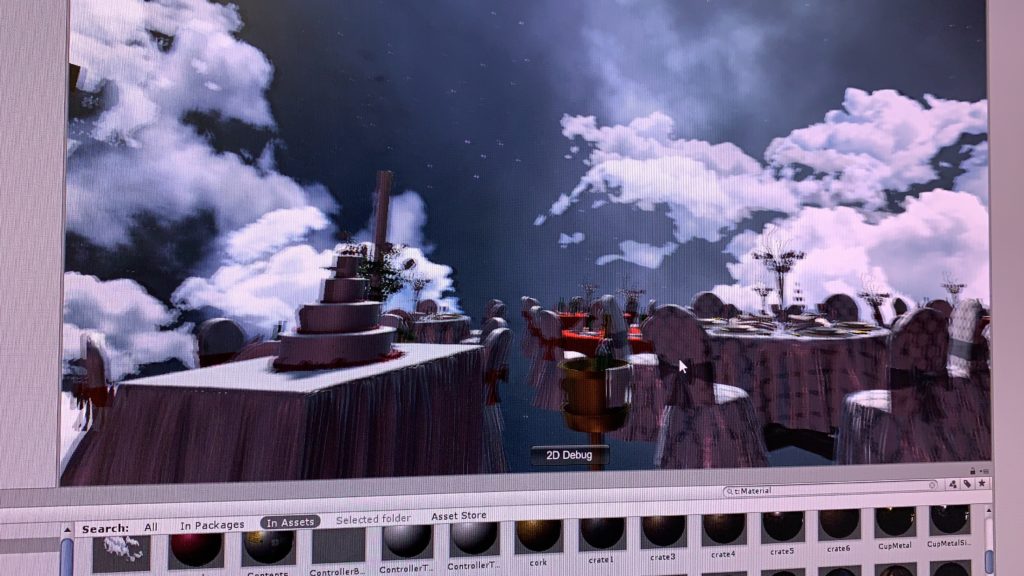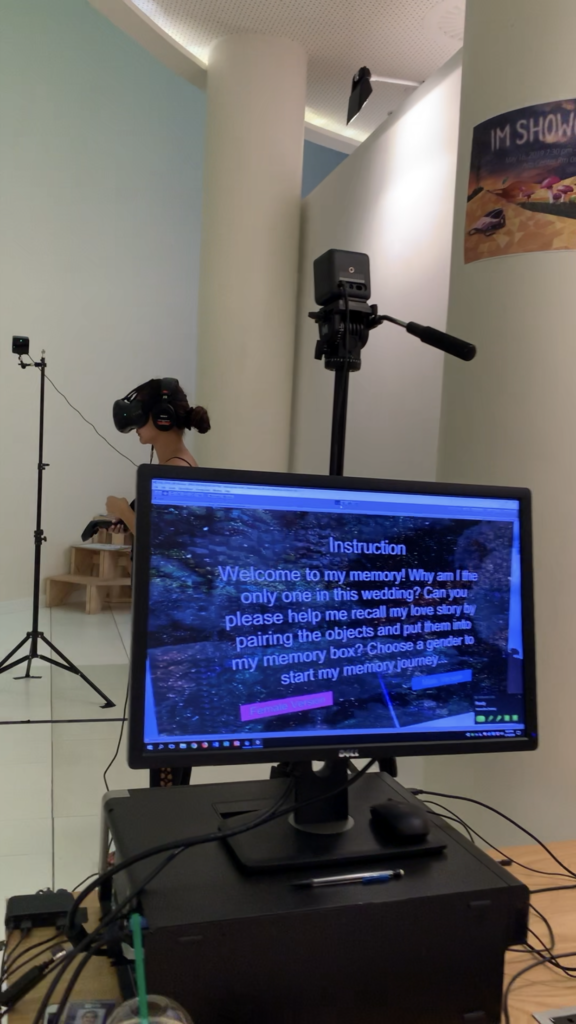Project Description
MemoryBox is an immersive experience for people to explore the love story buried in one’s memory. The aim is for users to interact with objects in the environment, and form their own understanding of the story based on how they interpret the hint they get from the scene. The experience was set inside someone’s memory, and user, upon they entered the scene, would have the choice of deciding whether they want to hear the female version or the male version of the story. After they make the choice, they enter an empty wedding scene inside the memory, and there are multiple daily objects and a cardboard box on the red carpet. Users will be instructed to pick up the objects, and put them into the box in pairs. There are five pairs of objects, the voiceovers triggered by which, when organized in order, make up a whole story, and one single object, which is supposed to be the “leftover” and the end of the story. However, the order in which user puts objects into the box does not matter, because we wanted to provide the users with freedom to interpret the story and blend in their own imagination. When all the objects are put into the box, the box will disappear, indicating that this story is erased from the memory.
Process and Implementation
The tasks were divided into two parts: environment and interaction. Initially I made a prototype to test out whether the pairing of the objects we chose make sense to the user. However, we failed to find prefabs for some of the objects we wanted, such as passport and flight ticket, and we had to modify the storyline a bit based on what kind of prefabs we were able to find. After having all the objects placed in our environment, we felt like rather than situating the scene in an abstract environment, a more realistic scene will make the interactions more intuitive for the user, so we decided to use the wedding scene as our environment. For the skybox, we used a skybox for a city at first. Then during the play testing, people said they were distracted by the skybox a bit and were really focusing on the details. Thus we decided to change the skybox to a more abstract one, which could at the same time strengthen the dreaminess of our scene.

My main task was to make the objects in our scene interactable, and to trigger different effects. By adding the interactable script and the throwable script to each object, and checking collision between the paired objects, I could attach the story pieces accordingly. When positioning the objects, I made sure that everything is placed within the play area, so that user can definitely reach the objects by walking around, which makes the experience of cleaning up and pairing up objects more real. Then during the play testing, we found that players might want to through objects away, and by doing so, they will never be able to get them back. To address that problem, I added a box that is the same size of the play area and made it transparent. Then by making the box collider as “isTrigger”, I checked whether the object stayed within the box. If not, I will reset the position of the object to its original position.
Then when Vivian and I was testing the game, we thought it is weird that the game does not have an ending scene. We initially thought about adding an animation of the box closing, when every object are put into the box and paired up. However, since the prefab we found for the cardboard box cannot be animated, we decided to make the box disappear, and have some visual effects when all the story pieces had been played. And for the first scene, as we planned, I set up a menu that allows user to choose which side of the story they want to hear about, and there’s also an instruction on the menu. The instruction was made “unclear” by purpose, so the user kind of know there task is to pair up objects, but do not know what they will see and what will actually happen in the scene.

Here’s some videos of people playing with our project during the IM showcase.
Reflection/Evaluation
Two main takeaways from this project:
- Details matter. Most of the issues I had during the process were due to my ignorance of details. For example, in order to make an object to be movable, the box says “static” should be unchecked.
- User do not always read the instructions. Even if we did more that three rounds of user testing and made adjustments to our project based on the feedback, our project was still kind of “hacked” during the showcase. This is true for all the IM projects I have made in the past: users can always interact with your project in an unexpected way. User testing is really really important.
I liked the idea of our project, but I hope if we have chance in the future, we can turn it into something more than an interactable love story. I always believed that VR can be an effective tool to assist with the treatment of mental health problems. If we can dig deeper into the story, we might be able to come up with a project that helps people who suffer to recover from their breakup.